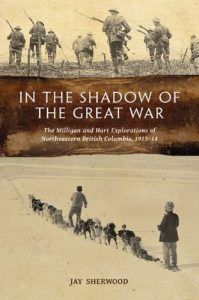Local Author and Historian Documents Early Plant Collections
The UBC Herbarium is pleased to announce the publication of Jay Sherwood’s latest book: In the Shadow of the Great War, the Milligan and Hart Explorations of Northeastern British Columbia, 1913-1914. The Vancouver-based author and historian visited the herbarium to research some of the earliest BC specimens of the collection – pressed and mounted plants dating back to 1913.

Sherwood’s historical text describes the precarious expeditions of George Milligan, a BC Land Surveyor, and E.B. Hart, an explorer, who for 18 months gathered information from the far north of British Columbia. Although Milligan and Hart kept detailed journals, reports, and correspondences, all of their work was filed away and forgotten with the advent of World War I.
One hundred years later, Jay Sherwood, a former surveyor himself, has unearthed and retold Milligan and Hart’s stories, creating a narrative that includes the men’s own notes and correspondences.

Rubus arcticus collected by E.B. Hart at Toad River, 1914
One story in the book describes E.B Hart’s role as a botanical correspondent to BC’s Provincial Botanist John Davidson (1878-1970). Davidson, or “Botany John” as he was known, was the founder of the UBC Botanical Gardens, the Vancouver Natural History Society, and UBC’s Herbarium collections — even before they were a part of the university. In 1914, Davidson created a program involving over a hundred correspondents from all over the province, which included E.B. Hart. His goal was to amass the first comprehensive collection of BC’s flora, a task that continues to this day.
Surveyor General George Dawson put E.B. Hart in touch with Davidson and Hart became Davidson’s first correspondent in Northeastern BC. Hart was not a botanist. Nor was he remotely, it seemed, interested in botany. But he nonetheless agreed to send specimens to Davidson’s burgeoning collection.
The amusing correspondence between E.B. Hart, John Davidson, and Surveyor General George Dawson is delightfully retold in Sherwood’s book, including extensive transcriptions of the three men’s original letters.
In this sample, Davidson explains his need for the botanical specimens:
Although botanical survey work is primarily of scientific importance, I think that its economic importance is often overlooked. A collection of specimens from a selected area is to the botanist, what a meteorological chart is to the meteorologist. From it he can tell something of the climate, exposure, length of growing season in that area, and is able to form an opinion as to its value […]
Hart, often travelling alone, facing hunger, inclement weather, and snow-blindness, writes to Dawson:
I can’t help but wondering whether [Davidson] fancies I’m travelling with a furniture van — and a list of names — botanical of course — of the plants I sent out last year. I regret to say […] his list does not contain much of value to me […]
Despite his disinterest, Hart continued to collect for Davidson sending in over one hundred specimens which, according to George Dawson had “doubtless travelled by many Indian packers before reaching mail communication.” Due to water and insect damage in the early 1900s, now only thirteen of the specimens remain in UBC’s Herbarium collections. They have been studied for their historical, botanical, and ecological importance by researchers over the last hundred years.

Anemone globosa collected by E.B. Hart at the junction of Trout and Wind Rivers, 1915
To read more about Hart’s and Milligan’s rocky adventures, with insights into the geography, politics and lifestyle of 1913 British Columbia, pick up a copy of Jay Sherwood’s In the Shadow of the Great War, now available at the UBC Bookstore and the Beaty Biodiversity Museum Store.
You can find Davidson’s, Hart’s, and other correspondents’ plant specimens in the UBC Herbarium Database.
